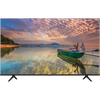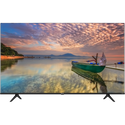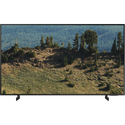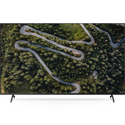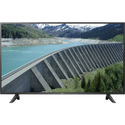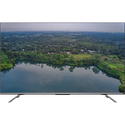A comparison of specs, key information, reviews, and best pricing from top retailers
Last updated -- hours ago | Report incorrect information
What we think

The PerfectRec TV team Learn more
Updated January 10, 2024·
The Hisense U6K generally offers better overall picture quality, especially in bright rooms and for movies, which may justify its higher price compared to the Hisense A6H. It has a higher contrast and better performance in dark rooms, making it suitable for watching movies with deep blacks. However, the A6H may be a better budget-friendly option for casual viewing and gaming. Keep in mind that neither TV excels in gaming performance, but the A6H is less expensive. If you prioritize superior picture quality for a variety of content, the U6K might be the better choice, assuming you're comfortable with a higher cost. Give Feedback
this description is based on the product variant with some specs and product variant with some specs. At the time of writing, the variant with some specs cost some dollars and the variant with some specs cost some dollars.
Advantages of the Hisense A6H (LCD)
- Good for upscaling
- Good viewing angle
Advantages of the Hisense U6K (LCD)
- Good for dark room
- Good for movies & TV
- Good for news, talk, & other TV
- Very good for cartoons & animation
Key differences
Picture Quality
5.2


7.5
3.35/10
CONTRAST
7.25/10
6.1/10
COLOR VOLUME SCORE
7.4/10
LED
PANEL TYPE
miniLED FALD
IPS
PANEL SUB-TYPE
VA
The Hisense U6K (LCD) has good picture quality, while the Hisense A6H (LCD) has poor picture quality.
Movies & TV
4.9


7.2
3.35/10
CONTRAST
7.25/10
5.4/10
BLACK UNIFORMITY
5.7/10
7.5/10
UPSCALING
6.6/10
Yes
HDR10 SUPPORT
Yes
Yes
HDR10+ SUPPORT
Yes
Yes
DOLBY VISION SUPPORT
Yes
The Hisense U6K (LCD) is good for movies & TV, while the Hisense A6H (LCD) is poor.
The Hisense A6H struggles with movies and cinematic TV mainly due to its poor contrast, absence of local dimming, and weak black uniformity, all of which are crucial for a good dark room viewing experience. Conversely, the Hisense U6K performs better for these types of content, thanks to its superior contrast enabled by mini-LED FALD technology, more effective local dimming, and better black uniformity.
Gaming
5.7


6.6
5.9/10
RESPONSE TIME SCORE
6.7/10
10.0/10
INPUT LAG SCORE
8.7/10
2.5/10
MOTION PROCESSING
3.2/10
0.0/100
GAMING LOCAL DIMMING
80.0/100
5.4/10
GAME HDR BRIGHTNESS SCORE
6.9/10
The Hisense U6K (LCD) is only fair for gaming, while the Hisense A6H (LCD) is poor.
The Hisense A6H is considered poor for gaming due to its poor response time and best input lag, meaning while it's quick to register inputs, the display may take longer to update, leading to blur in fast-paced games. Conversely, the Hisense U6K, rated as fair for gaming, has a fair response time and very good input lag, providing faster screen updates and more responsive gameplay but still not on par with higher-end gaming TVs.
Cartoons & Animation
5.7


8.1
5.9/10
COLOR GAMUT SCORE
8.3/10
6.1/10
COLOR VOLUME SCORE
7.4/10
5.5/10
SDR BRIGHTNESS SCORE
7.6/10
8.3/10
COLORS OUT OF THE BOX SCORE
7.9/10
7.7/10
GRAY UNIFORMITY
6.2/10
The Hisense U6K (LCD) is very good for cartoons & animation, while the Hisense A6H (LCD) is poor.
News, Talk, & Other TV
5.8


7.5
5.5/10
SDR BRIGHTNESS SCORE
7.6/10
7.5/10
UPSCALING
6.6/10
The Hisense U6K (LCD) is good for news, talk, & other TV, while the Hisense A6H (LCD) is poor.
Bright Room
5.4


6.9
7.8/10
VIEWING ANGLE
5.2/10
5.5/10
SDR BRIGHTNESS SCORE
7.6/10
5.3/10
HDR BRIGHTNESS SCORE
6.8/10
6.0/10
REFLECTIONS SCORE
6.3/10
The Hisense U6K (LCD) is only fair for bright room, while the Hisense A6H (LCD) is poor.
The Hisense A6H struggles in bright rooms due to its poor SDR and HDR brightness and only fair performance in handling reflections, which can lead to glare and reduced visibility. In contrast, the Hisense U6K is a better option for bright rooms since its good SDR brightness helps it maintain a clearer picture in well-lit environments, though it also has fair HDR brightness and reflections handling, which means it can still be affected by strong light sources.

Let Us Help Find Your Perfect TV
Find your new TV
Key similarities
Sports
6.1


6.0
2.5/10
MOTION PROCESSING
3.2/10
60Hz
REFRESH RATE
60Hz
10.0/10
INPUT LAG SCORE
8.7/10
7.5/10
UPSCALING
6.6/10
5.5/10
SDR BRIGHTNESS SCORE
7.6/10
Yes
HLG SUPPORT
Yes
The Hisense A6H (LCD) and Hisense U6K (LCD) are both only fair for sports.
The Hisense A6H, with a wider viewing angle and fair handling of reflections, suits more casual, group sports-watching in well-lit rooms but falls short with motion processing and response time for fast-paced action. The Hisense U6K, while it offers better contrast and motion processing which is good for dynamic sports scenes, has a narrower viewing angle and only fair reflection handling, making it less ideal for wider seating or bright rooms.
Cost
$650


$690
$200
$400
$600
$800
$1,000
$1,200
The Hisense A6H (LCD) has a price of $650 and the Hisense U6K (LCD) costs $690.
Give feedback
We’re constantly working to improve.
How the Hisense A6H (LCD) and the Hisense U6K (LCD) compare to other TVs
Spec Comparison
| Hisense A6H (LCD) | Hisense U6K (LCD) |
GENERAL | |||
|---|---|---|---|
| Price | |||
$650 | $690 | ||
Brand | |||
Brand | Hisense | Hisense | |
Release Date | |||
Release Date | April 3, 2022 | August 2, 2023 | |
Full name | |||
Full name | 65A6H | 65U6K | |
Screen Size | |||
Screen Size | 65" | 65" | |
Screen Resolution | |||
Screen Resolution | 4K | 4K | |
TV FEATURES | |||
|---|---|---|---|
Operating System | |||
Operating System | Google TV | Google TV | |
Sound Quality Score | |||
Sound Quality Score | 6.1/10 | 7/10 | |
NextGen Ready | |||
NextGen Ready | No | No | |
HDMI Ports | |||
HDMI Ports | 4 | 4 | |
Coax Ports | |||
Coax Ports | 1 | 1 | |
DISPLAY QUALITY SCORES | |||
|---|---|---|---|
Picture Quality Score | |||
Picture Quality Score | 5.3/10 | 7.5/10 | |
Bright Room Score | |||
Bright Room Score | 5.4/10 | 7/10 | |
Gaming Score | |||
Gaming Score | 5.8/10 | 6.7/10 | |
Movies & TV Score | |||
Movies & TV Score | 5/10 | 7.3/10 | |
Sports Score | |||
Sports Score | 6.1/10 | 6.1/10 | |
PHYSICAL | |||
|---|---|---|---|
Dimensions w/o Stand (H x W x D) | |||
Dimensions w/o Stand (H x W x D) | 32.8" x 57.2" x 2.9" | 33.1" x 57.1" x 3.1" | |
Dimensions with Stand (H x W) | |||
Dimensions with Stand (H x W) | 35.3" x 57.2" | 35.3" x 57.1" | |
Weight without Stand | |||
Weight without Stand | 36.4 lbs | 43.4 lbs | |
VESA Mount | |||
VESA Mount | 400 x 300 | 400 x 300 | |
DISPLAY | |||
|---|---|---|---|
Color Depth | |||
Color Depth | 10 bit | 10 bit | |
Black Frame Insertion | |||
Black Frame Insertion | No | Yes | |
Auto Low Latency Mode | |||
Auto Low Latency Mode | Yes | Yes | |
Contrast | |||
Contrast | 3.4/10 | 7.3/10 | |
Local Dimming | |||
Local Dimming | 2.5/10 | 6/10 | |
SOUND | |||
|---|---|---|---|
Speaker Setup | |||
Speaker Setup | 2.0 | 2.0 | |
Speaker Power | |||
Speaker Power | 28 W | 20 W | |
Dolby Atmos | |||
Dolby Atmos | Yes | Yes | |
DTS:X | |||
DTS:X | Yes | No | |
Get a great deal on the Hisense A6H (LCD) or the Hisense U6K (LCD)
About Hisense
Hisense, a Chinese TV manufacturer, entered the US market in approximately 2011 and has since acquired TV divisions from various companies such as Toshiba, Sharp, Hitachi, and NEC. Currently ranking as the fourth largest vendor in terms of sales volume, Hisense aims to capture a wide range of TV budget segments. They offer exceptional value with TVs that often outperform their competitors at similar price points, making them a compelling choice for consumers. In the US, they use Google TV as their smart TV software which provides the largest app selection and a very modern user interface, however it is not as user friendly as the software from other vendors.
Give feedback
We're constantly perfecting our model
TV guides you might be interested in
More comparisons for you
FAQs
FAQs about TVs
Why trust us
This information was produced and vetted by the PerfectRec TVs team. We are a product research and recommendation organization that meticulously reviews and evaluates the latest TV information and makes it digestible for you.
By the numbers
385
TVs evaluated
33,110
TVs stats compiled
21
Proprietary TVs ratings developed
174,930
Recommendations made
26,240
Consumer hours saved
About the TV team
Joe Golden, Ph.D
CEO and TVs Editor
Joe is an entrepreneur and lifelong electronics enthusiast with a Ph.D in Economics from the University of Michigan.
Jason Lew
Staff Expert & Software Engineer
Jason is a staff expert and software engineer that has been making laptop recommendations for 7 years and moderates one of the largest laptop subreddits.
Chandradeep Chowdhury
Staff Expert & Software Engineer
Chandradeep is a staff expert and software engineer and expert in televisions and monitors. He’s been making monitor recommendations for ten years.
Jaime Roldán
TVs Expert
Jaime is a Colombia-based TV expert. He is an electronics engineer with 8 years of experience in the telecom sector and has been making TV recommendations for 12 years.
